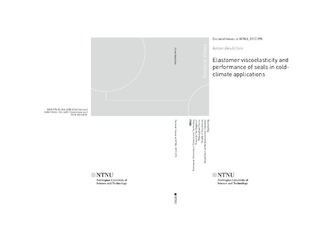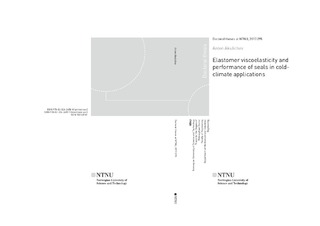| dc.contributor.advisor | Echtermeyer, Andreas | |
| dc.contributor.advisor | Espallargas, Nuria | |
| dc.contributor.author | Akulichev, Anton | |
| dc.date.accessioned | 2018-01-22T14:08:27Z | |
| dc.date.available | 2018-01-22T14:08:27Z | |
| dc.date.issued | 2017 | |
| dc.identifier.isbn | 978-82-326-2659-5 | |
| dc.identifier.issn | 1503-8181 | |
| dc.identifier.uri | http://hdl.handle.net/11250/2478797 | |
| dc.description.abstract | The Ph.D. thesis addresses the issues of elastomer seals operating in cold climate areas like Arctic. The work is devoted to a better understanding of low-temperature behaviour of elastomer seals near the glass transition Tg. The main objective of the work is to understand the causes for seal failures in cold environment and to establish a correlation between the low-temperature performance of hydrogenated nitrile butadiene rubber (HNBR) seals and the composition and the properties of the material. The basic material studied is HNBR with 96% saturated polybutadiene with 36% acrylonitrile content and varied carbon black (CB) content from 0 to 50 phr (parts per hundred rubber). A set of material and seal experiments was designed and carried out together with a finite element analysis (FEA) approach in order to accomplish the set goal. The major findings and novel results are as follows:
1. The relaxation function of the HNBR is found to be independent of strain at low temperatures down to −15 °C (≈ Tg + 8 °C) or times higher than ≈ 10−3 s. Therefore, the relaxation function of HNBR needed for FEA or other modelling can be measured at one single strain relevant for the application using the most convenient deformation mode. The relaxation function is also unaffected by the CB at the indicated temperatures and times, however it exhibits an increasing strain or CB dependency if the material is brought deeper into the glass transition region.
2. Compression set as a measure of elastic recovery in HNBR is found to increase with cooling. Below Tg, the HNBR compression strain field in HNBR is "frozen-in", i.e. the HNBR compounds demonstrate no recovery regardless of the presence of CB. Equivalence of time and temperature on the cold compression set is also shown. A viscoelastic model for prediction of the cold compression set using the stress relaxation data is proposed and validated against the FEA and experimental results.
3. The effect of cold adhesion is studied using a pull-off test set-up at ambient and low temperatures. The adhesion of HNBR to clean and smooth steel substrate is found to be low (e.g. pull-off force per unit length of O-ring fc ≈ 0.04 N/mm for 10% initial compression) at ambient temperature, while it dramatically increases below Tg and the pull-off force might reach 1-2 N/mm. The explanation is as follows. When the separation between HNBR and its counter-surface occurs at ambient temperature, the elastic deformation energy stored at the interface is given back during pull-off and helps to break the adhesive bonds resulting in the very small pull-off force values. When the contact pair formed at room temperature is cooled down below the Tg of HNBR, the elastic deformation imposed on the HNBR is "frozen-in" and the stored-up elastic energy is not given back during separation at the low temperature. This results in a giant pull-off force. It is also found that the contaminated or roughened contacting surfaces reduce fc to about 0.2 N/mm due to incomplete contact (lower relative contact area).
4. The cold performance of O-ring seals made of the HNBR compounds is studied using a vacuum test fixture. The seal failure temperatures under freezing conditions depend on the surface finish of the counter-face, seal compression ratio, lubrication and additions of CB in HNBR. The main reason for the seal failures is believed to be detachment of the elastomer seals from their mating sealing parts due to :
• breakage of the adhesion bond induced by the elastomer thermal contraction in case of a rather strong adhesion bond and negligible recovery of the HNBR below Tg
• or due to the thermal contraction and the negligible recovery when the strong adhesion bond is not formed.
5. It is shown that most of the cold failures can be modelled by the effective medium leakage theory and a simple FEA approach using thermo-mechanical material data the most important of which are the thermal expansivity and small-strain viscoelasticity of the elastomer compounds. The CB filled HNBR has a lower thermal expansion which results in a better retention of the sealing force and lower leakage temperatures if compared to the seals made of the unfilled HNBR. Hence, it can be inferred that better low-temperature serviceability in static applications can be achieved using elastomer compounds with low coefficients of thermal expansion (CTE) ideally close to the one of the seal housing material.
6. The low-CTE HNBR can be produced by adding negative thermal expansion (NTE) materials into the base elastomer composition. Low-CTE composites of HNBR − ZrW2O8 are produced and characterised in this work. The NTE effect in the composite is found to be stronger in the glassy state than in the rubbery plateau of the base elastomer. The reduction of CTE with the ZrW2O8 content is well described by the simple rule of mixture at temperatures above Tg, while Kerner and the upper bound of the Schapery models as well as a FEA homogenisation approach fit the CTE results below Tg better. The models can, thus, be used for prediction of the CTE of other elastomer composites. | nb_NO |
| dc.language.iso | eng | nb_NO |
| dc.publisher | NTNU | nb_NO |
| dc.relation.ispartofseries | Doctoral theses at NTNU;2017:295 | |
| dc.relation.haspart | Paper 1:
Akulichev, Anton; Alcock, Benjamin; Echtermeyer, Andreas.
Compression stress relaxation in carbon black reinforced HNBR at low temperatures. Polymer testing 2017 ;Volum 63. s. 226-235
https://doi.org/10.1016/j.polymertesting.2017.08.023 | |
| dc.relation.haspart | Paper 2:
Akulichev, Anton; Alcock, Benjamin; Echtermeyer, Andreas.
Elastic recovery after compression in HNBR at low and moderate temperatures: Experiment and modelling. Polymer testing 2017 ;Volum 61. s. 46-56
https://doi.org/10.1016/j.polymertesting.2017.05.003 | |
| dc.relation.haspart | Paper 3:
Akulichev A. G. et al. Rubber adhesion below the glass transition
temperature: Role of frozen-in elastic deformation. Europhysics Letters. ‒ 2017. ‒ Vol. 120, № 3. ‒ p. 36002.
https://doi.org/10.1209/0295-5075/120/36002 | |
| dc.relation.haspart | Paper 4:
Akulichev, Anton; Echtermeyer, Andreas; Persson, Bo.
Interfacial leakage of elastomer seals at low temperatures. International Journal of Pressure Vessels and Piping 2018 ;Volum 160. s. 14-23
© 2018. This manuscript version is made available under the CC-BY-NC-ND 4.0 license http://creativecommons.org/licenses/by-nc-nd/4.0/
The final published version is avialable at
https://doi.org/10.1016/j.ijpvp.2017.11.014 | |
| dc.relation.haspart | Paper 5:
Akulichev, Anton; Alcock, Benjamin; Tiwari, Avinash; Echtermeyer, Andreas Thorsten.
Thermomechanical properties of zirconium tungstate/hydrogenated nitrile butadiene rubber (HNBR) composites for low-temperature applications. Journal of Materials Science 2016 ;Volum 51.(24) s. 10714-10726
- Is not included due to copyright avialable at
https://doi.org/10.1007/s10853-016-0236-6 | |
| dc.title | Elastomer viscoelasticity and performance of seals in coldclimate applications | nb_NO |
| dc.type | Doctoral thesis | nb_NO |
| dc.subject.nsi | VDP::Technology: 500::Mechanical engineering: 570 | nb_NO |

